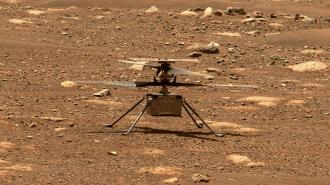NASA’s overachieving Mars helicopter just set two world records in a single day, flying higher and faster than ever before — and foreshadowing a future in which fleets of helicopters zip across the Red Planet.
The background: In February 2021, the Ingenuity helicopter landed on Mars along with NASA’s Perseverance rover. Two months later, it flew straight up 10 feet, hovered for 30 seconds, and then landed — earning a place in history as the first craft of any kind to fly on another planet.
NASA’s hope when launching Ingenuity was that the helicopter would be able to perform five test flights during its month-long mission — but it has flown 48 times since its initial flight, racking up nearly 90 minutes of flight time and covering almost 7 miles of distance.
“You can imagine in the future you will have fleets of these Mars Science Helicopters flying around.”
Teddy Tzanetos
What’s new? Ingenuity’s most recent flight occurred on April 2, and the Mars helicopter set two new records, reaching a top speed of 14.5 mph and a maximum altitude of 52.5 feet.
According to NASA’s mission flight log, its previous records were 13.4 mph (set during Flight 45) and 46 feet (set during Flight 35) for speed and altitude, respectively.
Why it matters: Flying on Mars was a huge engineering challenge — the planet’s atmosphere is much thinner than Earth’s, so Ingenuity’s designers had to figure out how to make the chopper as light as possible, but also powerful enough to generate the thrust needed to fly.
The effort was worth it, though, as having a craft capable of flying over Mars’ rough terrain gives NASA a way to explore areas potentially too dangerous for rovers — Ingenuity has been able to map and scout areas of potential interest for Perseverance during its extended mission.
NASA is already designing additional Mars helicopters inspired by Ingenuity, including the in-development Sample Recovery Helicopters, which will help Perseverance get Mars soil and air samples into the Sample Retrieval Lander for return to Earth, if needed.
Ingenuity is also helping NASA develop the Mars Science Helicopter, a hexacopter about the size of Perseverance capable of carrying payloads weighing up to 11 pounds.
“You can imagine in the future you will have fleets of these Mars Science Helicopters flying around, bringing important payloads to areas of Mars that we’ve never been able to access before,” said Ingenuity Team Lead Teddy Tzanetos.
Looking ahead: Ingenuity is still in great shape, with minimal dust on its solar panels, and NASA plans to keep pushing the limits of the Mars helicopter with faster, higher flights, according to Tzanetos.
“She’s done a fantastic job,” he said. “Surpassed any sort of metric of success that anyone on the team could have ever imagined for this little tiny 4-pound spacecraft.”
We’d love to hear from you! If you have a comment about this article or if you have a tip for a future Freethink story, please email us at tips@freethink.com.
